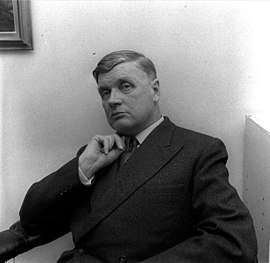Uuno Klami
Uuno (Kalervo) Klami (20 September 1900 – 29 May 1961) was a Finnish composer. He was born in Virolahti. Many of his works are related to the Kalevala. He was influenced by French and Spanish music, and especially by Maurice Ravel, for whom he had a particular esteem.[1]

The core of Klami's oeuvre consists of an assortment of works related to the Finnish national epic, the Kalevala, among the most notable being: the five-movement Kalevala sarja (Kalevala Suite; 1933, r. 1943), inspired by Stravinsky's The Rite of Spring; the symphonic poem, Lemminkäisen seikkailut saaressa (Lemminkäinen’s Island Adventures; 1934); and, the unfinished ballet, Pyörteitä (Whirls), which survives as two suites. As central to Klami's legacy is the six-movement orchestral suite, Merikuvia (Sea Pictures; 1932); the Karelian Rhapsody (1927); and, Psalmus (1936), an oratorio for soloists, mixed, chorus and orchestra. He also wrote two numbered symphonies, in 1938 and 1945, respectively, as well as two piano concerti (1925, 1945), a Violin Concerto (1943), and the Cheremissian Fantasy for cello and orchestra (1931).
He participated in five armed conflicts, including two wars in Karelia, the Finnish Civil War, the Winter War of 1939–40 and the Continuation War of 1941–44.
Biography
Klami studied music in Helsinki with Erkki Melartin and later in Paris and Vienna. Klami's Karelian Rhapsody, part of his first composition concert in 1928, was a succès de scandale that brought him considerable attention. His main works include the Kalevala Suite and the unfinished ballet Whirls. The oratorio Psalmus (1936) has a unique place in Finnish sacred music and is one of the most highly regarded works by a Finn other than Sibelius. Klami also experimented with the symphonic form in his two Symphonies (1938 and 1945) and Symphonie enfantine (1927), and the concerto form in his two Piano Concertos (No. 1 Une nuit à Montmartre and No. 2 for Piano and Strings) and the Violin Concerto (1943). Being a master of miniature orchestral works, the orchestral suite Sea Pictures is also regarded as one of his major achievements. On the recommendation of Sibelius he was granted a small lifetime income from the government. In 1959 he was made a member of the Finnish Academy (one of Finland's highest honors).
Klami died of a heart attack in Virolahti at age 60 while sailing his favorite boat "Miina".
Major compositions
- Piano Concerto No. 1, Op. 8 Une nuit à Montmartre (1925)
- Scenes from a Puppet Theatre (1925, orch. 1931)
- Karelian Rhapsody, Op. 15 (1927)
- Symphonie enfantine, Op. 17 (1928)
- Opernredoute, Op. 20 (1929)
- Cheremissian Fantasy for Cello & Orchestra, Op. 19 (1931)
- Hommage à Haendel, Op. 21 (1931)
- Sea Pictures, Op. 22 (1930–32)
- Scenes from a Country Life (1932)
- Sérénades joyeuses (1933)
- Helsinki March (1934)
- Lemminkäinen’s Adventures on the Isle of Saari (1935)
- Karelian Dances (1935)
- The Cobbler on the Heath, overture (1936)
- Psalmus for soloists, chorus and orchestra (1932–36)
- Suite for String Orchestra (1937)
- Symphony No. 1 (1937–38)
- In the Belly of Vipunen for baritone, men's chorus, & orchestra (1938) from The Kalevala
- Suomenlinna, overture Op. 30 (1940)
- Kalevala Suite, Op. 23 (1933-1943)
- Concerto for Violin & Orchestra, Op. 32 (1943)
- King Lear, overture, Op. 33 (1944)
- Symphony No. 2, op. 35 (1945)
- The Prodigal Son, incidental music to the play by Marin Držić (1945)
- The Cyclist, rondo for orchestra (1946)
- Suite for small orchestra, Op. 37 (1946)
- Karelian Marketplace, Op. 39 (1947)
- Revontulet / Aurore boréale ("Northern Lights"), fantasy for orchestra, Op. 38 (1948)
- Concerto No. 2 for Piano & Strings, Op. 41 (1950)
- All’Ouvertura, Op. 43 (1951)
- Tema con 7 variazioni e coda for cello & orchestra, Op. 44 (1954)
- Song of Moon Lake for baritone & orchestra (1956)
- Pyörteitä (“Whirls”), ballet inspired by the Kalevala (Act One piano score orchestrated by Kalevi Aho, Act Two completed, Act Three lost) (1957–60)
- The Bearer of the Golden Staff, cantata (1960–61)
References
- Tyrväinen, Helena. "Klami, Uuno (Kalervo)". Grove Music Online. Oxford Music Online. Retrieved 27 February 2014. (subscription required)
Sources
- Aho, Kalevi & Valkonen, Marjo: Uuno Klami: Elämä ja teokset. Werner Söderström Osakeyhtiö, Helsinki, 1999. ISBN 951-0-25249-2
- Korhonen, Kimmo: "Inventing Finnish Music." Finnish Music Information Centre 2003.
- Lehtonen, Tiina-Maija: "Uuno Klami: Works." Suomen Kultuurirahaston Kymenlaakson rahasto 1986.
- Tyrväinen, Helena: "The Success Story of the Man Who Forged the Sampo." Finnish Music Quarterly 2/2000 pp. 2–11.
Further reading
- Tyrväinen, Helena: Kohti Kalevala-sarjaa: Identiteetti, eklektisyys ja Ranskan jälki Uuno Klamin musiikissa. (Dissertation.) Acta Musicologica Fennica, 30. University of Helsinki, 2013. ISSN 0587-2448. ISBN 978-951-98479-9-3. 978-951-98479-9-3 On-line version.
External links
- Information on Klami at the Wayback Machine (archived May 3, 2008)
- Uuno Klami Society's main page (in Finnish)
- International Uuno Klami Composition Competition